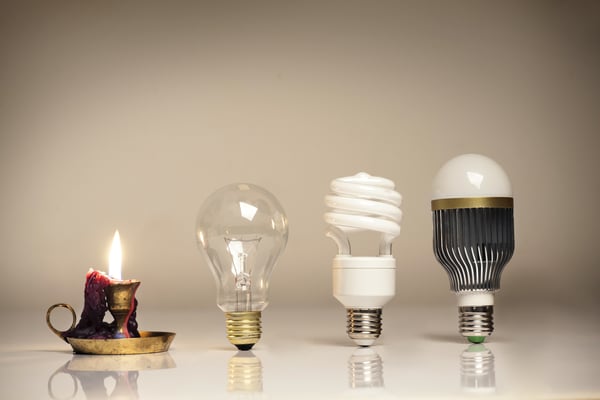Energy Efficiency Upgrades: LED Lighting

Energy efficiency measures are among the best investments available for building owners. These upgrades achieve a permanent reduction of electricity and gas bills, accumulating significant savings during the building’s service life. Energy efficiency also increases the value of buildings: apartments and commercial spaces for rent become more attractive for potential tenants.
Since each building is unique, the optimal combination of energy efficiency measures changes accordingly. However, some measures apply for almost any property. This article discusses LED lighting, and it will be the first in a series of articles focusing on energy savings.
Improve the energy efficiency of your building and reduce your power bills.
Benefits of LED Lighting in Residential and Commercial Buildings
It is common knowledge that LEDs offer a higher efficiency than older lamp types. The following table summarizes the typical savings achieved when replacing some common types of lighting:
|
Lighting Type Upgraded to LED |
Typical Savings |
|
Incandescent lamps |
80% - 90% |
|
Halogen lamps |
80% - 90% |
|
Compact fluorescent lights (CFL) |
25% - 40% |
|
Fluorescent tubes |
40% - 60% |
|
High intensity discharge (HID) lamp |
55% - 75% |
The energy savings are evident when upgrading to LED lighting, but there are more benefits. LED lamps and fixtures have a much longer service life than the lighting systems they upgrade, which results in less lamp replacements over time. When comparing the same lamp types in the table above, the increase in service life is the following:
|
Lighting Type |
Typical Service Life |
Equivalent LED Service Life |
|
Incandescent lamps |
800 - 1,200 hours |
15,000 - 25,000 hours |
|
Halogen lamps |
2,000 hours |
15,000 - 25,000 hours |
|
CFL |
8,000 - 12,000 hours |
15,000 - 25,000 hours |
|
Fluorescent tubes |
18,000 - 27,000 hours |
50,000 - 100,000 hours |
|
HID lamp |
10,000 - 24,000 hours |
50,000 - 100,000 hours |
When the entire service life of a building is considered, the lamp replacements saved by LED lighting are significant. For example, one LED bulb with a price of $6.00 is more expensive than one incandescent bulb with a price of $1.50. However, the LED bulb actually replaces 25 incandescent bulbs over time, which have a total price of $37.50 in this case.
LED lighting offers additional energy savings in air conditioned spaces or cold storage facilities. LEDs emit less heat than the lamps replaced, reducing the workload on cooling equipment.
Recommendations When Upgrading to LED Lighting
Depending on how much the lighting system is modified, LED upgrades can be classified into three main types:
- Relamp: The lamp replacement does not modify the existing fixtures, power sources and internal wiring. The new LED lamps are compatible with the existing sockets and connections.
- Retrofit: The lighting upgrade reuses the existing fixtures, with changes to their internal configuration and wiring. For example, some LED retrofit kits bypass the ballasts used by fluorescent and HID lamps.
- Complete Replacement: Lighting fixtures are removed completely, and replaced with integrated LED fixtures.
A complete fixture replacement is more expensive than relamping or retrofitting, but the resulting efficiency is slightly higher. If you only plan to improve the lighting system, a relamp or retrofit is quick and cost-effective. On the other hand, if you are planning a major renovation that includes new lighting, a full replacement is recommended.

Complete LED fixtures are recommended in new projects, to take advantage of their superior efficiency. Since you must invest in a lighting system anyway, going for the most efficient option is a smart decision. In this case, the “upgrade cost” is simply the price difference between both options.
Before purchasing lighting products, a simple but effective recommendation is looking for a certification label. ENERGY STAR and DesignLights Consortium (DLC) are two of the most popular programs, and both have stringent requirements before labeling a lighting product. Note that both labels are mutually exclusive, which means that having one is enough. If a lighting product is eligible for both labels, ENERGY STAR has a higher priority because it is managed by a federal agency (US EPA).
Conclusion
If you get an energy audit for your building, it is very likely that an LED upgrade with be among the recommendations. Improving the lighting system is relatively simple, compared with other energy efficiency measures. Payback periods of less than four years are common when upgrading to LED, and some upgrades achieve a payback period of less than one year.
Professional guidance is strongly recommended before a lighting upgrade, like with any other engineering decision. LED lamps are fixtures are characterized by their variety: there is a product for every application, but you must also ensure you purchase a suitable upgrade.

Michael Tobias
Michael Tobias, the Founding Principal of NY Engineers, currently leads a team of 150+ MEP/FP engineers and has led over 4,000 projects in the US
Join 15,000+ Fellow Architects and Contractors
Get expert engineering tips straight to your inbox. Subscribe to the NY Engineers Blog below.

